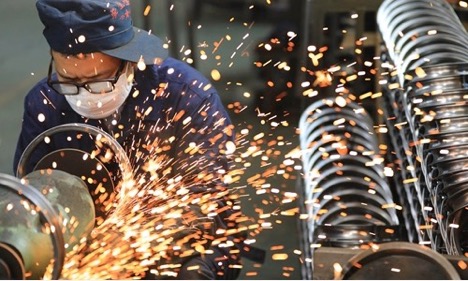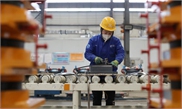
A worker is polishing a steel ring for a bicycle at a company in Hangzhou, East China's Zhejiang Province on April 13. Photo: cnsphoto
After turning in its first contraction on record in the first quarter amid the coronavirus pandemic, China's economy is solidly back on a growth track in the second quarter, market estimates collected by the Global Times show, a feat that sets the economy apart from the rest of the world that is still seeing the deadly disease acutely undermine growth.
Business owners and industry insiders, who have survived the growth-freeze and job-slashing pandemic, say they were prepared for the worst but are now seeing things are turning out better than expected. Attributing the snap-back V-shaped rebound largely to the nation's swift and effective coronavirus response, they told the Global Times that it is the nation's institutional advantages that helped them out of the virus plight and are unfazed by new challenges expected during the remainder of the year.
As a veteran entrepreneur who has gone through multiple crises including the 1997-98 Asian financial crisis and the 2008 global financial crisis, Wei Guoxian, founder of Jiangsu Shengli Tools Co, an export-oriented hardware tools manufacturer, said that the COVID-19-induced economic hit is the worst he's ever encountered.
Wei's company exports 95 percent of its products to overseas markets including the US, Europe and Southeast Asia. It was raking in a gross profit margin of 20 percent annually before the pandemic slammed its business, Wei sold the Global Times.
The nation's quick COVID-19 response has helped reboot the economy to the amazement of Wei's overseas clients, and has effectively alleviated damage to a broad band of businesses betting on an economic rebound.
"I had hoped the company would break even - the best possible result for the year - but it seems now we'll remain slightly profitable," Wei said with relief.
He cited the government's decision to waive employers' social insurance payments that helped eases pressure and maintain jobs.
A snap-back in sight
Other entrepreneurs are anticipating a thriving economy that's slated to report an expansion of close to 3 percent from its worst quarter.
China was the first major economy affected by COVID-19, but thanks to its efforts to contain the virus, it is also the first major country to reopen most of its economy, Lu Ting, an economist with Nomura said in a note sent to the Global Times.
The economy has staged an impressive comeback since mid-March, "bolstered by pent-up demand, a catch-up in production, a surge in medical product exports and stimulus in both China and other major economies that has bolstered demand for goods made in China," Nomura's researchers said as they forecast for real GDP growth to 2.6 percent year-on-year for the second quarter up from a previous prediction of 1.2 percent.
A raft of economic indicators, notably the quarterly GDP, are scheduled to be announced by the National Bureau of Statistics (NBS) on Thursday. The economy contracted 6.8 percent on a yearly basis in the first quarter, previous NBS data showed.
China's GDP in the second quarter may witness growth, as the country has made remarkable achievements in epidemic control and prevention of imported cases, said Zhao Jinping, former head of the foreign economic research department at the Development Research Center of the State Council.
Along with the speeding up domestic production recovery since April, manufacturing activities in the second quarter may recover to the level of last year, and an investment drop in the sector will narrow in the latest months, he told the Global Times. "We will see stronger momentum in domestic consumption recovery in the second quarter."
Wanda Group told the Global Times the conglomerate has opened three new Wanda Plazas in China, with each of them providing 4,000 new jobs on average with more than half of the positions open to graduates.
"Compared with the first quarter, Wanda Plazas have seen significant improvement in the second quarter, thanks to the well-implemented epidemic control and prevention measures, release of consumption vouchers, rent-free policies of Wanda and various campaigns to boost consumer confidence," Wanda said, adding all 326 Wanda Plazas across China have recovered operations, except cinemas and the goal to build 45 new plazas this year remains unchanged.
Just over 47 percent of urban jobs are created in the services industry in China, official data showed, making it a vital job source.
Powering ahead
But what exactly makes the Chinese economy so resilient to warrant being singled out by the IMF as the only major economy to post positive GDP growth this year in its latest world economic growth projections released in late June?
The Washington-based fund estimated that China's economy would grow by 1 percent in 2020 before expanding 8.2 percent in 2021. Its global outlook projection foresees a contraction of 4.9 percent this year and a 5.4 percent growth in 2021. The US economy was forecast to shrink 8 percent this year before growing 4.5 percent the next year.
Zhang Jiening's experience could arguably give a glimpse into the fundamental vitality of the economy, which has institutional advantages that allow companies like Zhang's to survive transitory economic bruising from the pandemic.
Zhang has run Lotus Restaurant in Shanghai since 2004. The two-floor restaurant of about 500 square meters had revenue of about 400,000 yuan a month before the coronavirus. Now epidemic control measures have eased, and even more gourmets are visiting the restaurant and monthly revenue has increased to around 450,000 yuan. The eatery specializes in Hubei cuisine, and the increase in guests mainly comes from people from Hubei which was hit hardest by the virus in China.
"Even if I felt sad when my parents in Hubei only had potatoes, pumpkin and sausages to eat in February, as a person graduating from biology major, I was confident that China is capable of containing the COVID-19 within a short period of time after seeing reassuring epidemic control measures," Zhang told the Global Times, adding he paid his employees during the two-month shutdown from his personal saving and a bank load, as 80 percent of the employees come from Hubei which was locked down for several months.
The restaurant's 70 percent-recovery in the second quarter was beyond Zhang's expectations. Sales of the restaurant's stored-value cards doubled compared with the same quarter last year, because "many people are showing their love toward Hubei and willing to support its recovery."
In a note sent to the Global Times, Goldman Sachs economists wrote that "there were two negative shocks without which activity growth would have been even stronger."
They cited the second outbreak in Beijing, which they noted was a very local outbreak that was quickly controlled by aggressive policies and consequently "the impacts on the national economy were likely modest."
The other shock is heavy flooding in parts of southern China, the economists said, who expect a second quarter GDP growth of 2 percent year-on-year.
"China has submitted a satisfactory answer sheet in stabilizing its economy," said Zhao who believes the Chinese economy will account for a notably bigger part of the global economy when the pandemic grinds to a halt.
Unrecovered international travel and disrupted global supply chain may have a greater impact in the third quarter, said Zhao. The interruption of the supply of spare parts produced abroad and lack overseas orders may influence China's manufacturing.
Wei says his business could be subject to potentially greater uncertainty in months to come, as some of the clients have canceled orders while some have postponed their orders due to the still raging disease outside of China.
But the stronger-than-expected first half - proof that the Chinese economy will only press ahead with indomitable will - instills him with confidence about what lies ahead for the rest of the year.

